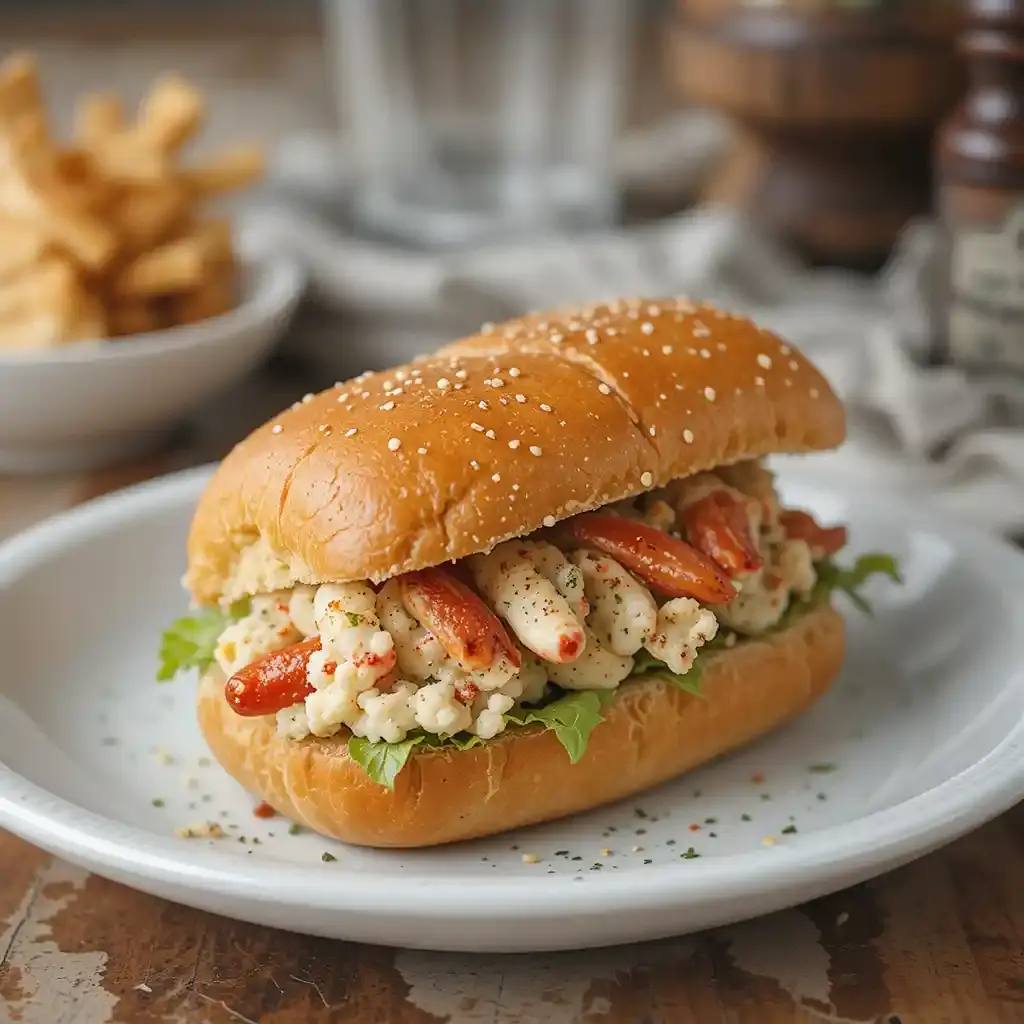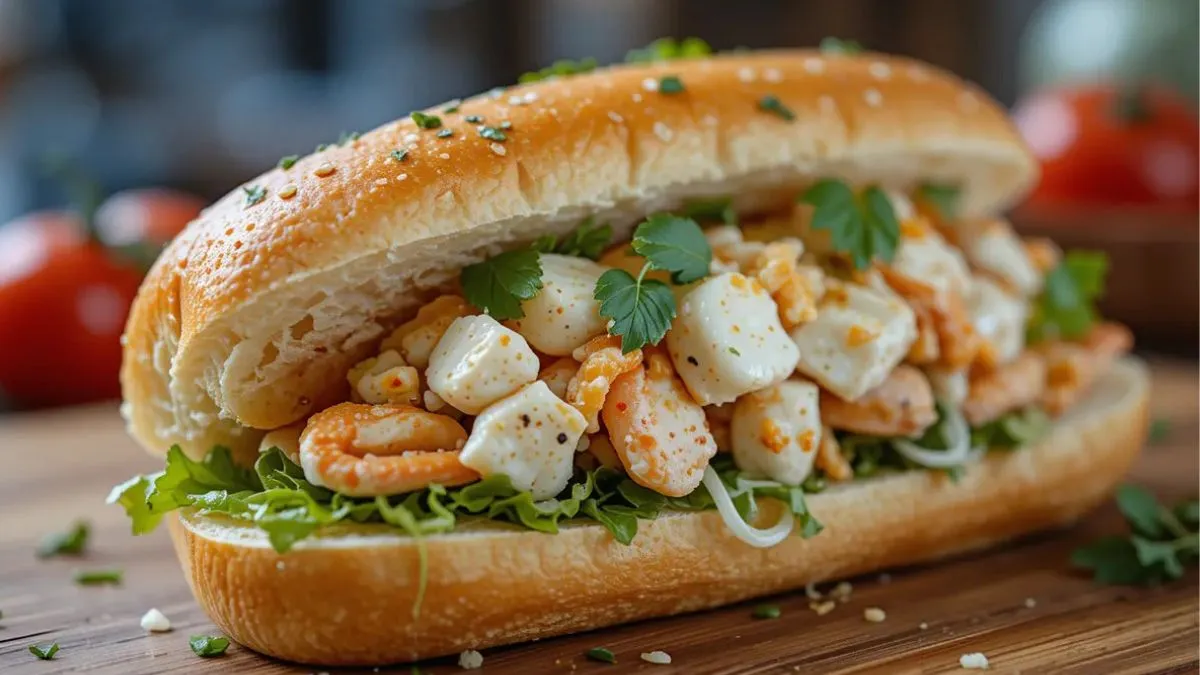Table of Contents
Crab Roll Recipe: A Refreshing and Delicious Seafood Sandwich
Discover the ultimate seafood sandwich that captures the essence of coastal cuisine: the crab roll. This delightful dish transforms fresh crab meat into a mouthwatering meal. It screams summer and seaside dining. Your perfect crab roll recipe combines succulent seafood with crisp, toasted bread for an unforgettable culinary experience.
Originating from New England’s rich seafood tradition, the crab roll has become a beloved staple. It’s a light yet satisfying seafood sandwich. Whether you’re a home cook or a culinary adventurer, mastering this recipe will elevate your summer meal repertoire.
Key Takeaways
- Crab rolls represent a classic coastal American seafood dish
- Fresh ingredients are crucial for an authentic crab roll recipe
- The sandwich offers a perfect balance of texture and flavor
- Preparation requires minimal cooking skills
- Versatile enough for casual lunches or elegant gatherings
Understanding the Classic New England Crab Roll
Seafood rolls are a big part of American food history. The New England crab roll is especially loved. It’s more than just a meal; it’s a trip through coastal culture.
History of Seafood Rolls in American Cuisine
Seafood rolls started in New England’s coastal towns. Fishermen and restaurants made them to enjoy fresh seafood. Over time, crab rolls became a way to show off the area’s seafood.
- Originated in coastal New England fishing communities
- Developed as a practical seafood preparation method
- Reflected local maritime culinary traditions
Different Regional Variations
While the New England crab roll is famous, other areas have their own versions. Each one adds its own twist to this tasty sandwich.
| Region | Unique Characteristic |
| Maine | Cold mayo-based crab filling |
| Connecticut | Warm butter-dressed crab meat |
| Massachusetts | Mixed herb seasoning |
What Makes a Perfect Crab Roll
Making a great crab roll takes care. It’s all about using fresh crab and the right seasonings. The aim is to highlight the natural flavor of the crab.
“A perfect crab roll celebrates simplicity and fresh ingredients.”
The New England crab roll has come a long way. It’s loved for its history and delicious taste.
Essential Ingredients for Your Crab Roll
Making the perfect crab roll begins with picking top-notch seafood. The ingredients you choose will shape the taste and texture of this beloved dish.
Key Ingredients Breakdown
- Crab Meat: The star of your seafood roll components
- Mayonnaise for binding
- Fresh herbs for flavor
- Crisp vegetables for crunch
- Premium bread rolls
When picking crab roll ingredients, go for fresh, high-quality ones. They should enhance the seafood’s delicate flavor.
| Ingredient Category | Recommended Options | Quality Indicators |
| Crab Meat | Dungeness, King, Lump | Fresh, white, minimal shell fragments |
| Binding Agent | Mayonnaise, Light Aioli | Creamy, not overpowering |
| Herbs | Chives, Dill, Parsley | Freshly chopped, vibrant color |
“The secret to an amazing crab roll lies in the quality of your ingredients.”
Your seafood roll components should balance to showcase the crab’s sweet flavor. Don’t let too many flavors compete with the crab.
Selecting and Preparing Fresh Crab Meat
Choosing the right crab meat is key to a great crab roll. Knowing the difference between fresh and canned crab can make your seafood sandwich a hit with your guests.
Types of Crab Suitable for Rolls
Some crab types are better for crab rolls because of their taste and texture. Here are the best ones:
- Blue crab: Sweet and delicate
- Dungeness crab: Rich and nutty
- King crab: Big chunks for rolls
- Snow crab: Mild taste, tender
Fresh vs Canned Crab Meat
Fresh crab meat vs canned crab is a big debate. Let’s look at their differences:
| Fresh Crab Meat | Canned Crab |
| Superior taste and texture | Convenient and budget-friendly |
| More prep time needed | Ready to use right away |
| More expensive | Less costly |
Proper Cleaning and Handling Techniques
Proper crab handling is important for safety and flavor. Here’s how to prepare fresh crab meat:
- Remove shells and cartilage carefully
- Rinse under cold water
- Pat dry with paper towels
- Store in fridge right away
Pro tip: Buy fresh crab from trusted markets and use within 1-2 days for the best taste.
Whether you choose fresh or canned crab, proper preparation is key. It will make your crab roll a hit.
Creating the Perfect Crab Roll Filling
Making a great crab roll filling is like an art. It turns simple seafood salad into a tasty sandwich. The secret is using top-notch ingredients and mixing them just right.
Start by selecting the finest crab meat for your salad. Fresh or high-quality canned crab is key. Break the crab into small pieces to keep it tender.
- Use fresh mayonnaise as a creamy base
- Add finely chopped celery for crunch
- Incorporate fresh herbs like chives or dill
- Add a pinch of salt and white pepper for seasoning.
Your filling should be creamy but light. Pro tip: Don’t overmix. Gently fold the ingredients to keep the crab meat tender and the salad smooth.
“The key to an exceptional crab roll is honoring the natural flavor of the crab meat.”
Try these flavor boosts to make your filling even better:
- Lemon zest for brightness
- Dijon mustard for subtle tang
- Minced red onion for sharpness
- Chopped parsley for fresh herbal notes
Chill the filling for 30 minutes before serving. This lets the flavors blend, making your crab rolls unforgettable.
Choosing and Preparing the Right Bread
The bread you pick can make or break your crab roll. Finding the perfect bread is key to a tasty seafood sandwich.
Bread is vital for the texture and taste of your crab roll. Not all bread is good for making the best seafood dish.
Traditional Split-Top Rolls
Split-top rolls are the top choice for real crab rolls. They have many benefits:
- Flat sides perfect for even toasting
- Soft interior that complements delicate crab meat
- Classic New England style presentation
When picking split-top rolls, choose fresh ones. They should be sturdy to hold your crab filling well.
Toasting and Butter Techniques
Toasting your bread makes the crab roll better. Here are some tips for toasting:
- Butter the exterior sides of the split-top rolls
- Use a hot griddle or skillet for even browning
- Toast until golden brown and crispy
Pro tip: Brush melted butter on the rolls before toasting. This makes them golden and adds flavor.
“The secret to an amazing crab roll is in the bread preparation”

Step-by-Step Guide to Assembling Your Crab Roll
Learning to make crab rolls is all about precision and care. With these easy steps, you’ll turn fresh ingredients into a tasty seafood sandwich.
- Prepare Your Workspace
- Gather all ingredients: crab meat, bread rolls, mayonnaise, seasonings
- Ensure your work surface is clean and organized
- Have mixing bowls and utensils ready
- Mix the Crab Filling
- Gently fold crab meat with mayonnaise
- Add chopped herbs like chives or parsley
- Season with salt and pepper to taste
- Prepare the Bread
- Lightly butter split-top rolls
- Toast rolls until golden brown
- Let rolls cool slightly before filling
When making crab rolls, handle them gently. Overmixing can break down the crab meat, compromising the quality of your dish.
“The perfect crab roll is a delicate balance of fresh seafood and careful preparation.”
| Step | Key Action | Tip |
| 1. Crab Preparation | Drain excess moisture | Pat crab meat dry with paper towels |
| 2. Filling Creation | Mix gently | Use folding technique to preserve meat texture |
| 3. Roll Assembly | Fill rolls generously | Avoid compressing crab meat |
The last step is to present your crab rolls well. Serve immediately to enjoy the best flavor and texture. This way, your crab roll recipe will impress everyone with its freshness.
Essential Tips for Seasoning and Flavoring
Making tasty crab rolls is all about finding the right mix of flavors. This mix should bring out the crab’s natural sweetness. Knowing how to match these flavors can turn a simple crab roll into a memorable dish.
Perfect Herb and Spice Combinations
Choosing the right herbs and spices is key when it comes to crab roll flavors. Fresh ingredients can make your seafood sandwich even better.
- Chives: Add a mild onion-like brightness
- Fresh dill: Provides a classic maritime accent
- Parsley: Offers a clean, fresh undertone
- Old Bay seasoning: Delivers a traditional seafood kick
Balancing Flavor Profiles
Getting the flavors right in crab rolls is all about balance. You want to add to the crab’s taste without overpowering it.
| Ingredient | Flavor Impact | Recommended Quantity |
| Lemon Zest | Bright, Citrusy | 1 teaspoon per cup of crab |
| Mayonnaise | Creamy Base | 2-3 tablespoons |
| Dijon Mustard | Tangy Undertone | 1 teaspoon |
Pro tip: Always taste and adjust seasonings gradually to maintain the crab’s delicate flavor profile.
“The secret to great crab rolls lies in respecting the seafood’s natural taste while adding subtle complementary notes.”
Serving Suggestions and Side Dishes
Make your crab roll meal special with the right side dishes. These can turn a simple meal into a memorable one. Selecting the perfect sides can enhance your dining experience.
- Classic Potato Chips: A crispy, salty accompaniment that adds texture
- Coleslaw: Creamy and tangy, balancing the rich crab meat
- Mixed Green Salad: Light and refreshing seafood sandwich pairing
- Pickles: Zesty crunch that cuts through the sandwich’s richness
Pair your seafood sandwich with drinks that enhance the crab’s flavor. Here are some great options:
| Beverage | Flavor Profile | Recommended Pairing |
| Sauvignon Blanc | Crisp, Citrusy | Excellent with cold crab rolls |
| Pilsner Beer | Light, Refreshing | Perfect summer drink |
| Iced Tea | Cool, Neutral | Family-friendly option |
Try different sides to find the perfect mix for your meal. This way, you can enjoy the crab roll’s flavors to the fullest.
The right side dish can transform a good meal into an unforgettable culinary journey.
Make-Ahead and Storage Tips
Preparing and storing crab rolls can make enjoying this tasty seafood sandwich easier. Learning how to store and reheat crab rolls helps keep their fresh taste and texture.
Best Practices for Storing Crab Rolls
Storing Seafood Rolls right is key to keeping them fresh and safe. Here’s how to keep your seafood sandwich at its best:
- Refrigerate crab rolls right after making them
- Use an airtight container to stop moisture loss
- Keep them refrigerated for no more than 1-2 days
- If you need to store them longer, separate the filling from the bread
Effective Reheating Methods
Reheating seafood sandwiches needs care to avoid soggy bread and tough crab. Here are some good ways to do it:
- Take the crab filling out of the bread before heating it up
- Warm the filling a bit in a skillet over low heat
- Quickly toast the bread to make it crisp again
- Put the sandwich together just before eating it
“The secret to reheating a crab roll is preserving its original freshness and texture.”
By using these storage and reheating tips, you can enjoy tasty crab rolls even if you made them ahead of time. Always remember to keep food safety and quality in mind when working with seafood.
Common Mistakes to Avoid When Making Crab Rolls
Making the perfect seafood sandwich needs careful attention. Crab roll mistakes can ruin a tasty meal. Knowing these common errors helps you make a delicious crab roll every time.
- Ingredient Quality Matters: Bad crab meat is a big mistake. Always pick fresh, high-quality crab for the best taste and texture.
- Avoid Overmixing: Fold your ingredients gently to keep the crab meat’s delicate texture.
Seafood sandwich tips start with good preparation. Here are key mistakes to avoid:
| Mistake | Solution |
| Excess Mayonnaise | Use just enough to bind ingredients without drowning the crab meat |
| Improper Seasoning | Balance flavors with light herbs and minimal salt |
| Bread Selection | Choose fresh, soft rolls that complement the crab filling |
Temperature control is key when making your crab roll. Keep ingredients cold and avoid leaving seafood at room temperature for too long. A cold filling keeps the best texture and avoids food safety problems.
“The secret to an exceptional crab roll lies in the details of preparation and ingredient selection.”
- Use fresh herbs sparingly
- Toast rolls lightly for extra texture
- Drain excess moisture from crab meat
Avoiding these common crab roll mistakes makes your seafood sandwich amazing. Follow these tips, and you’ll become a crab roll expert quickly.
Conclusion
Making homemade crab roll is an art that needs fresh ingredients, careful prep, and a love for seafood. Your journey shows how simple steps can make a meal special.
The secret to great crab rolls is using top-notch crab meat, knowing how to season, and picking the right bread. You can make them Maine-style with cold mayo or Connecticut-style with warm butter, based on what you like.
Try adding different herbs, spices, and sides to make your crab rolls stand out. Start with the basics from this guide, and soon you’ll make crab rolls like a pro. Remember, practice and passion are key to being great in the kitchen.
Your new skills will wow your family and friends, making a simple seafood sandwich into a fancy treat. Enjoy making crab rolls your own special dish.
FAQ
What type of crab meat is best for a crab roll?
Lump crab meat or jumbo lump crab meat are top picks for seafood. They offer tender, high-quality meat with large chunks. This gives your seafood sandwich the best flavor and texture.
Can I substitute fresh crab meat with canned?
Yes, canned crab meat works too. But fresh crab meat tastes and feels better. If using canned, pick high-quality lump crab meat and drain it well before making your roll.
How does a crab roll differ from a lobster roll?
The main difference is the seafood. Crab rolls use crab meat, while lobster rolls use lobster. Both have similar preparation and seasoning, but each has its own taste and regional twists.
How long can I store prepared crab rolls?
Store crab rolls in an airtight container in the fridge for 1-2 days. For the best taste, eat them right after making. This keeps them fresh and tasty.
Are crab rolls typically served hot or cold?
Crab rolls can be hot or cold, depending on where you are. New England-style rolls are often cold with light mayonnaise. Other places might have warm, buttery crab meat.
What are the best bread options for crab rolls?
Split-top New England-style rolls are the classic choice. They’re flat and can be toasted and buttered. If you can’t find these, a soft white bread works well too.
How can I prevent my crab roll from becoming too watery?
To avoid too much moisture, drain and pat dry your crab meat. Use just a little dressing and avoid watery veggies. Choose a thick mayonnaise or drain it well.
What are some good seasonings for crab rolls?
Use fresh chives, dill, lemon zest, Old Bay seasoning, and black pepper. These light, fresh herbs enhance the crab’s flavor without overpowering it.

